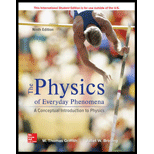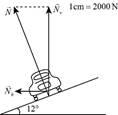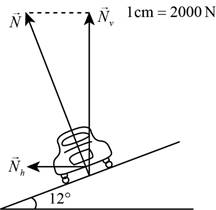
Concept explainers
A car with a mass of 1100 kg is traveling around a curve with a radius of 50 m at a constant speed of 25 m/s (56 MPH). The curve is banked at an angle of 12 degrees.
- a. What is the magnitude of the centripetal acceleration of the car?
- b. What is the magnitude of the
centripetal force required to produce this acceleration? - c. What is the magnitude of the vertical component of the normal force acting upon the car to counter the weight of the car?
- d. Draw a diagram of the car (as in fig. 5.8) on the banked curve. Draw to scale the vertical component of the normal force. Using this diagram, find the magnitude of the total normal force, which is perpendicular to the surface of the road.
- e. Using your diagram, estimate the magnitude of the horizontal component of the normal force. Is this component sufficient to provide the centripetal force?
(a)
The magnitude of the centripetal acceleration of the car.
Answer to Problem 3SP
The magnitude of the centripetal acceleration of the car is
Explanation of Solution
Given Info: The radius of the curve is and the speed of the car is
Write the equation for the centripetal acceleration.
Here,
Substitute
Conclusion:
Thus the magnitude of the centripetal acceleration of the car is
(b)
The magnitude of the centripetal force required to produce the centripetal acceleration.
Answer to Problem 3SP
The magnitude of the centripetal force required to produce the centripetal acceleration is
Explanation of Solution
Given Info: The mass of the car is
Write the equation for centripetal force.
Here,
Substitute
Conclusion:
Thus the magnitude of the centripetal force required to produce the centripetal acceleration is
(c)
The magnitude of the vertical component of the normal force acting upon the car to counter the weight of the car.
Answer to Problem 3SP
The magnitude of the vertical component of the normal force acting upon the car to counter the weight of the car is
Explanation of Solution
Given Info: The mass of the car is
The vertical component of the normal force acts to counter the weight of the car so that vertical component of normal force is equal to the weight of the car.
Write the equation for the weight of the car.
Here,
The value of
Substitute
Conclusion:
Thus the magnitude of the vertical component of the normal force acting upon the car to counter the weight of the car is
(d)
Diagram of the car on the banked curve to scale the vertical component of the normal force and determine the magnitude of the total normal force.
Answer to Problem 3SP
The diagram of the car on the banked curve is

and the magnitude of the total normal force is
Explanation of Solution
Given Info: The angle of banking of the curve is
The diagram of the car in the curve is shown in figure 1.

Figure 1
Write the equation for the vertical component of the normal force.
Here,
Rewrite the above equation for
Substitute
Conclusion:
Thus the diagram of the car on the curve is drawn in figure 1 and the magnitude of the total normal force is
(e)
The magnitude of the horizontal component of the normal force and whether it is sufficient to provide the centripetal force.
Answer to Problem 3SP
The magnitude of the horizontal component of the normal force is
Explanation of Solution
Given Info: The angle of banking of the curve is
Write the equation for the horizontal component of the normal force.
Here,
Substitute
Conclusion:
Thus the magnitude of the horizontal component of the normal force is
Want to see more full solutions like this?
Chapter 5 Solutions
Physics of Everyday Phenomena
- The pilot of an airplane executes a loop-the-loop maneuver in a vertical circle. The speed of the airplane is 300 mi/h at the top of the loop and 450 mi/h at the bottom, and the radius of the circle is 1 200 ft. (a) What is the pilots apparent weight at the lowest point if his true weight is 160 lb? (b) What is his apparent weight at the highest point? (c) What If? Describe how the pilot could experience weightlessness if both the radius and the speed can be varied. Note: His apparent weight is equal to the magnitude of the force exerted by the seat on his body.arrow_forward(a) A 22.0 kg child is riding a playground merry-go-round that is rotating at 40.0 rev/min. What centripetal force must she exert to stay on if she is 1.25 m from its center? (b) What centripetal force does she need to stay on an amusement park merry-go-round that rotates at 3.00 rev/min if she is 8.00 m from its center? (c) Compare each force with her weight.arrow_forwardA pail of water is rotated in a vertical circle of radius 10.00 m. (a) What two external forces act 011 the water in the pail? (b) Which of the two forces is most important in causing the water to move in a circle? (c) What is the pails minimum speed at the top of the circle if no water is to spill out? (d) Assume the pail with the speed found in part (c) were to suddenly disappear at the top of the circle. Describe the subsequent motion of the water. Would it differ from the motion of a projectile?arrow_forward
- . A hang glider and its pilot have a total mass equal to 120 kg. While executing a 360° turn, the glider moves in a circle with an 8-m radius. The glider’s speed is 10 m/s. (a) What is the net force on the hang glider? (b) What is the acceleration?arrow_forwardA woman places her briefcase on the backseat of her car. As she drives to work, the car negotiates an unbanked curve in the road that can be regarded as an arc of a circle of radius 62.0 m. While on the curve, the speed of the car is 15.0 m/s at the instant the briefcase starts to slide across the backseat toward the side of the car. (a) What force causes the centripetal acceleration of the briefcase when it is stationary relative to the car? Under what condition does the briefcase begin to move relative to the car? (b) What is the coefficient of static friction between the briefcase and seat surface?arrow_forward(a) What is the radius of a bobsled turn banked at 75.0° and taken at 30.0 m/s, assuming it is ideally banked? (b) Calculate the centripetal acceleration. (c) Does this acceleration seem large to you?arrow_forward
- Helicopter blades withstand tremendous stresses. In addition to supporting the weight of a helicopter, they are spun at rapid rates and experience large centripetal accelerations, especially at the tip. (a) Calculate the magnitude of the centripetal acceleration at the tip of a 4.00 m long helicopter blade that rotates at 300 rev/min. (b) Compare the linear speed of the tip with the speed of sound (taken to be 340 m/s).arrow_forwardA car moves at speed v across a bridge made in the shape of a circular arc of radius r. (a) Find an expression for the normal force acting on the car when it is at the top of the arc. (b) At what minimum speed will the normal force become zero (causing the occupants of the car to seem weightless) if r = 30.0 m?arrow_forwardA car of mass 1 230 kg travels along a circular road of radius 60.0 m at 18.0 m/s. (a) Calculate the magnitude of the cars centripetal acceleration. (b) What is the magnitude of the force of static friction acting on the car? (See Section 7.4.)arrow_forward
- Modem roller coasters have vertical loops like the one shown here. The radius of curvature is smaller at the top than on the sides so that the downward centripetal acceleration at the top will be greater than the acceleration due to gravity, keeping the passengers pressed firmly into their seats. (a) What is the speed of the roller coaster at the top of the loop if the radius of curvature there is 15.0 m and the downward acceleration of the car is 1.50 g ? (b) How high above the top of the loop must the roller coaster start from rest, assuming negligible friction? (c) If it actually starts 5.00 m higher than your answer to (b), how much energy did it lose to friction? Its mass is 1.50103kg .arrow_forwardBanked curves are designed so that the radial component of the normal force on the car rounding the curve provides the centripetal force required to execute uniform circular motion and safely negotiate the curve. A car rounds a banked curve with banking angle = 22.0 and radius of curvature 150 m. a. If the coefficient of static friction between the cars tires and the road is s = 0.400, what is the range of speeds for which the car can safely negotiate the turn without slipping? b. What is the minimum value of s for which the cars minimum safe speed is zero? Note that friction points up the incline here.arrow_forwardObjects moving along a circular path have a centripetal acceleration provided by a net force directed towards the center. Identify the force(s) providing the centripetal acceleration in each of these cases: (a) a planet in circular orbit around its sun; (b) a car going around an unbanked, circular turn; (c) a rock tied to a string and swung in a vertical circle, as it passes through its highest point; and (d) a dry sock in a clothes dryer as it spins in a horizontal circle.arrow_forward
 Physics for Scientists and Engineers: Foundations...PhysicsISBN:9781133939146Author:Katz, Debora M.Publisher:Cengage Learning
Physics for Scientists and Engineers: Foundations...PhysicsISBN:9781133939146Author:Katz, Debora M.Publisher:Cengage Learning College PhysicsPhysicsISBN:9781305952300Author:Raymond A. Serway, Chris VuillePublisher:Cengage Learning
College PhysicsPhysicsISBN:9781305952300Author:Raymond A. Serway, Chris VuillePublisher:Cengage Learning University Physics Volume 1PhysicsISBN:9781938168277Author:William Moebs, Samuel J. Ling, Jeff SannyPublisher:OpenStax - Rice University
University Physics Volume 1PhysicsISBN:9781938168277Author:William Moebs, Samuel J. Ling, Jeff SannyPublisher:OpenStax - Rice University College PhysicsPhysicsISBN:9781285737027Author:Raymond A. Serway, Chris VuillePublisher:Cengage Learning
College PhysicsPhysicsISBN:9781285737027Author:Raymond A. Serway, Chris VuillePublisher:Cengage Learning Physics for Scientists and Engineers with Modern ...PhysicsISBN:9781337553292Author:Raymond A. Serway, John W. JewettPublisher:Cengage Learning
Physics for Scientists and Engineers with Modern ...PhysicsISBN:9781337553292Author:Raymond A. Serway, John W. JewettPublisher:Cengage Learning Physics for Scientists and Engineers, Technology ...PhysicsISBN:9781305116399Author:Raymond A. Serway, John W. JewettPublisher:Cengage Learning
Physics for Scientists and Engineers, Technology ...PhysicsISBN:9781305116399Author:Raymond A. Serway, John W. JewettPublisher:Cengage Learning





